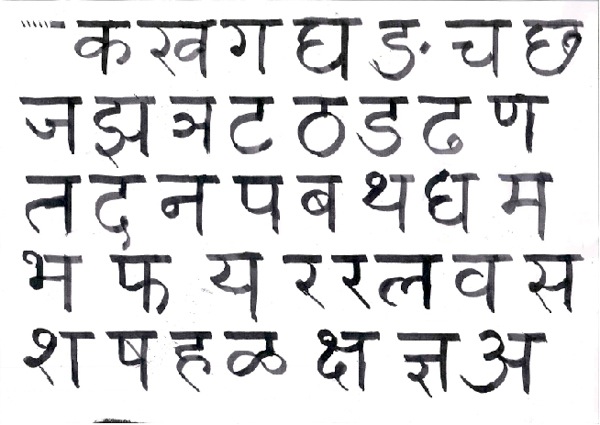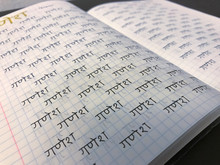THIS BOOK is ALL about learning to write the Devanagari alphasyllabary script (Sanskrit is technically not an alphabet). This book uses the same method myself and millions of American school children use (d) to learn to write their English A-B-Cs. Someone else posted a photo of the lessons. See what I mean? Devanagari (देवनागरी) is an Abugida script used to write numerous languages of south Asian country. It also called Devanagari Lipi. Devanagari is a conjunction of Sanskrit Language (term): deva + Nagari. The term Deva refers to “god,” and the term Nagari refers to “script or lipi of the city”.
ĐevaNāgarī Varṇamālā (वर्णमाला)
ĐevaNāgarī (देवनागरी) is a widely used script (लिपि; lipi). It is used by more than 250 million people! It is used for writing text of Hinđī, Marāthī, Nepālī, Sanskṛiŧ and many other regional languages and dialects in the Indian subcontinent. Illiteracy is reducing in India, more and more people are beginning to read and write in ĐevaNāgarī.
If you want to see pictures of ĐevaNāgarī alphabets and skip the introduction of Nāgarī click following.
Introduction
The alphabet of Nāgarī is called 'Varṇamālā' (वर्णमाला). It is also called 'kakaharā' (ककहरा) or 'Akṣhar-mālā' (अक्षरमाला; Akshar-mala)! Varṇa means letter; mālā means chain or garland.
Akṣhar (अक्षर)

Simply speaking an Akṣhar is a letter.
Akṣhar means something immortal. 'kṣhar' (क्षर) means 'cease to exist' or 'which will not remain'. 'A' is used here as 'un', so 'Akṣhar' means something 'which remains' (nonperishable)! Knowledge remains in the form of Akṣhar/s.
In a chapter titled 'Akṣhar Vijṅān (Vign'yān)' of a book titled 'Vaiđik Sampaŧŧi', 'Akṣhar' is compared to an atom! (Then 'conjuncts'/'syllables' become molecules. ;-)
'kṣhar' also means 'Ajṅān' (Agn'yān; lack of knowledge), so we can say 'Akṣhar' mean 'not lack of knowledge' or 'knowledge'!
MāŧrāEn̐ (मात्राएँ)
In Hinđī & Sanskṛiŧ, māŧrā (मात्रा) means extent or amount! So a māŧrā represent amount of a vowel. Every vowel (except one) has a corresponding sign (or mark) called its māŧrā.
Do not make plural of māŧrā simply by appending 's' (like māŧrās); because in Hinđī, the word māŧrāEn̐ (मात्राएँ) denotes plural form of māŧrā.
The nasalization mark 'chanđra-binđu' ( ँ ), is also called a māŧrā.
Marks or signs of consonants like 'Anusvār', 'visarg', 'reph' and 'rakār' are also called māŧrāEn̐! We will see what these marks means and how they look like!
ĐevaNāgarī is Syllabic
In ĐevaNāgarī, we do not simply write characters one after the other.
The māŧrāEn̐ are applied over Akṣhar/s to form syllables. A māŧrā represent an 'amount' (or presence) of a vowel (or a consonant) in a syllable. [Syllable = शब्द-खन्ड]
Remember a māŧrā is applied over an Akṣhar like a diacritic is applied over a letter in Latin. The main difference is that many of the māŧrāEn̐ connect to Akṣhars while diacritics generally do not connect to the letters.
A conjunct is called a 'joḍ-Akṣhar' ('joḍ' means join or joint).
Tentative Nāgarī Varṇamālā
In ĐevaNāgarī, we can study alphabets under following categories.
| 1. | Svar/s (स्वर / Vowels & Diphthongs) | 13 |
| 2. | V'yanjan/s (व्यंजन / Consonants) | 33 |
| 3. | MāŧrāEn̐ (मात्राएँ / Vowel-Signs) | 12 |
| 4. | Chihn/s (चिह्न / Marks) | 08 |
| 5. | Āvash'yak joḍakṣhar/s (आवश्यक जोड़ाक्षर / Essential Conjuncts) | 10 |
| 6. | Ank/s (अंक / Digits) | 10 |
| 7. | Virām chihn/s (विराम चिह्न / Punctuation Marks) | 10 |
| 8. | Anya (अन्य / Miscellaneous) | 08 |
Devanagari Alphabet Francais

So, there are more than 100 basic letter-forms in ĐevaNāgarī.
The first thought that comes to one's mind is that in comparison to about 70 characters in English you have to learn more than 100 alphabets in ĐevaNāgarī. Let me remind you that it is not only about learning more characters, it is more than that. As you may know there are some rules for writing/forming ĐevaNāgarī words. But almost all the primary school students learn it without much of difficulty.
Think of the big reward! -
You will be able to write anything you speak - A N Y T H I N G !!
without having to worry much about how it will be pronounced.
You Write What You Speak
ĐevaNāgarī is a phonetics based script; words are written mainly according to their pronunciations. So it is more suitable for writing text of many languages. There are rules for pronouncing a written word. Possibility that a written word is pronounced differently is very less in Nāgarī. So, generally we get clear pronunciations of written words.
Indic languages do not require memorizing spellings. We need to be a bit careful about which māŧrā (vowel sign) is correct for a particular word; which also help in correctly pronouncing that word. It also help in preserving the correct pronunciations of words!

No one should copy any text from the pages of vigyan.net, hindi.co, softfonts.com, devanagari.in and omgayatri.com. If you find similar text at other sites please inform us.
Devanagari Alphabet How Many Letters
Varnmala is not a correct spelling!
These pages use our 'Nīrajā-Latin'. transliteration scheme for writing ĐevaNāgarī words in Latin.
Total Pageviews: Updated: Aug 20